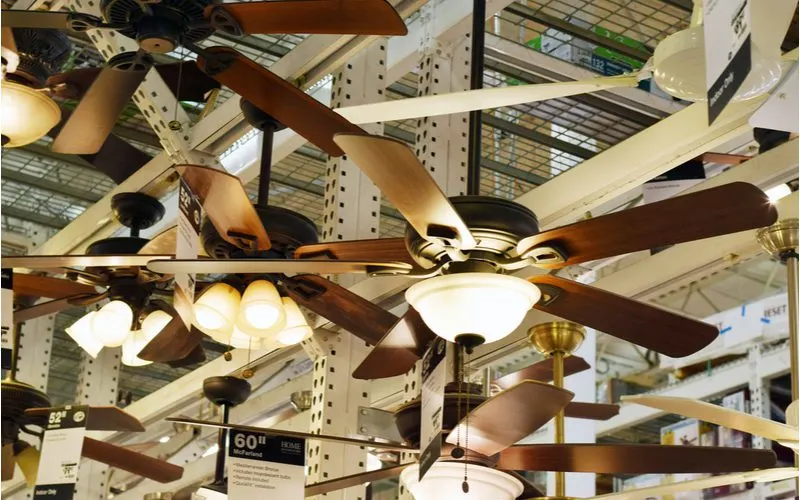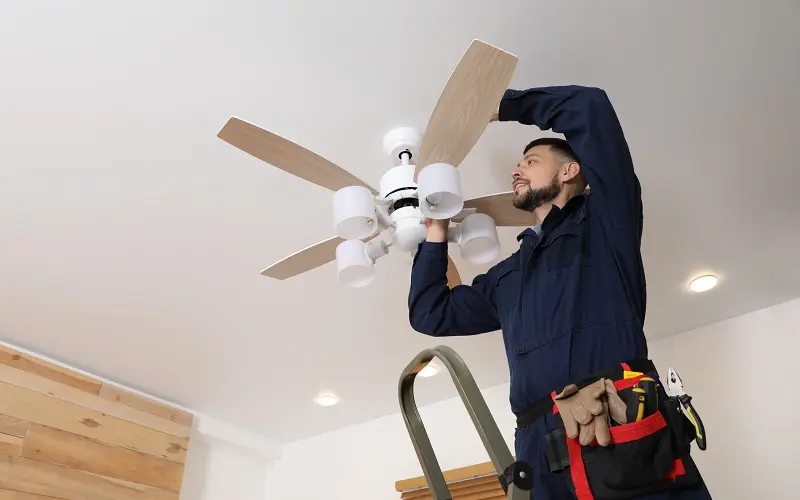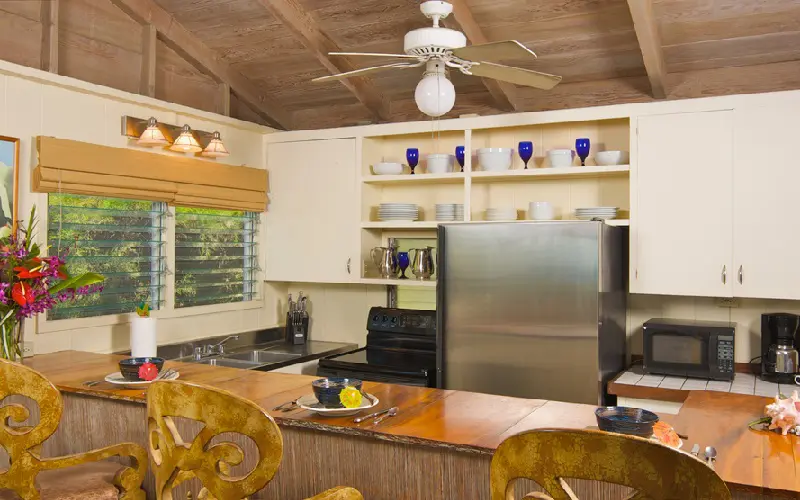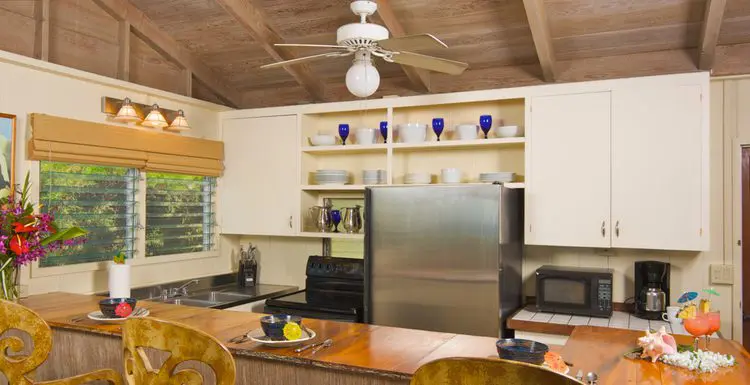Is it a good idea to have a ceiling fan in kitchen?
While there may be restrictions on installing a ceiling fan in your kitchen, it is a good idea, depending on the layout of your house.
There are benefits and things you should know about kitchen ceiling fans before committing to your decision.
Most people might agree that it is way too hot in the summer months to cook—but could a ceiling fan be the solution to all your problems, or will it cause more trouble?
We’ll cover all of this and more below, so read on.
Can You Use a Ceiling Fan in Kitchen?
The answer is yes. It’s possible to install a ceiling fan in a kitchen. Upgrading your kitchen with a ceiling fan has several benefits, including improving air circulation and maintaining a comfortable temperature. It also helps eliminate cooking odors.
However, the average size of a kitchen is somewhere between 160 and 170 square feet. Not all ceiling fans will be a good fit for this small area.
You need at least eight inches of clearance between the blades and the ceiling for proper airflow. There should be at least 18 inches between the tip of the blades and the walls and seven feet between the fan and the floor.
Kitchens tend to use the vertical space available with fixtures like wall cabinets, range hoods, or built-in microwaves. These elements can restrict the clearance available and call for installing a fan with short blades.
Benefits of Having a Kitchen Ceiling Fan

JR-Stock/Shutterstock
Features to finding the best ceiling fan for your kitchen make all the difference. One thing most ceiling fans have in common are mentioned below:
Energy Saving
Most air conditioners and heating appliances use three to five percent more energy than a ceiling fan.
A ceiling fan costs very little to run and gives you a four-degree temperature decrease.
Cost-Efficient
With a ceiling fan, you can choose multiple speeds and the direction in which to push the air. With this effect, an air conditioner or other cooling device is needed less, which will help you save on costs during the summer months.
During the winter months, you can use your fan to help circulate the stagnant air left behind from odors and closed windows.
So, the costs in the winter go down as well due to how much your fan will circulate the air. Other things that matter are:
Blades and Shapes Matter
The cubic feet per minute (CFM) description on the box will help you determine how much airflow the fan pushes out. A higher number means more airflow.
While noise may bother some people, it’s not the mechanical drone of an air conditioner but the swishing of air movement. Fewer ridges, bumps, and textures make less noise.
Wobbles Are Easily Fixable
Most fans include a balancing kit that comes with instructions on how to install it. However, if such fans do not include a balancing kit, they are fairly cheap and can be accessed almost everywhere.
Heating and Cooling Effects
The summer months can be uncomfortably warm. Ceiling fans decrease the indoor temperature by at least four to five degrees. While an air conditioner may be more comforting, a ceiling fan circulates the air more efficiently.
Just like summer, the winter months can be uncomfortably cold, and with all windows closed and the heat on high, the air becomes stagnant quickly.
The cool thing about a ceiling fan is that one direction pushes the air down to make the air cooler, and the other direction pushes the air up, which makes the air warmer.
Keeps Flies and Flying Pests Away
Constant movement, air circulation, and swooshing noise cause a 75% decrease in flying insects.
Flying insects prefer stagnant air or calm wind movements. A ceiling fan makes their wings dispel more, ultimately keeping them away, so they don’t have to work as hard.
Eliminate Most Odors
Most stand-up fans draw air through one side and push air out through the other.
The circulation of the fan depends on how much odor is decreased through the process of the machine.
Ceiling fans push air down (depending on the direction you choose) and out of the room as it turns in a tornado-like motion.
Types of Kitchen Ceiling Fans

Cabeca de Marmore/Shutterstock
Finding the perfect fan can be extremely difficult. There are all these questions ruminating through one’s mind.
How big does it need to be? Where will it be placed? How much air does the household need? Does it need a light fixture? Will it compliment my kitchen?
Let’s take a detailed look at the types of ceiling fans there are.
Long Blades vs. Short Blades
Take a look at your kitchen. How big is it? If you have a small kitchen, you’re going to opt for shorter-bladed fans.
Longer-bladed fans are for larger rooms as they generate more airflow for larger spaces. Then again, the motor is the power behind how much airflow the fan can push out.
Three or Five Blades?
Five blades create more wind because the distance between the blades is shorter than that of a three-bladed fan. Five blades are also less noisy than three blades.
However, a three-blade fan moves the air around the room faster. A three-blade fan is also more stylish and elegant.
Light vs. No Light

New Africa/Shutterstock
Whether or not to have a ceiling fan with a light bulb depends on the individual. If you have a darker kitchen, opt for a fan with a light fixture. If you care about energy efficiency, fans without light bulbs are your option
Remote vs. No Remote
Some ceiling fans come with a remote to control certain times when the fan turns on or off.
If you’re a busy person, a control may be your best option, as you can also switch the speed and function while sitting down.
AC vs. DC Motors
The main difference between a DC motor and an AC motor is the voltage of the battery. A DC fan is fixed, ranging from 5V to 48V. An AC motor fan has an ever-changing voltage ranging from 100 VAC to 240 VAC.
DC fans are more energy-efficient, quieter, and use less voltage. AC fans use more energy to run but cool down and circulate air quicker.
What Type of Ceiling Fan Is Best for a Kitchen?

Andy Dean Photography/Shutterstock
A standard ceiling fan that doubles as a light fixture is the best ceiling fan for most kitchens. With a wide range of sizes and styles available, finding a standard ceiling fan that matches your kitchen should be easy.
If you have a kitchen with a low ceiling, a low-profile or flush-mounted fan will be a better option. These fans sit closer to the ceiling since they don’t use a down rod. They compensate for the limited clearance by using curved blades to enhance airflow.
Whether you opt for a standard or low-profile fan, choosing an Energy-Star product is an excellent decision. Fans with an Energy Star certification use 60% less energy, and the built-in light fixture will produce less heat.
You should also think about investing in a fan with smart features that support voice control, so you can easily turn your fan on and off as needed.
Things to Consider Before Installing a Ceiling Fan in the Kitchen

JR-Stock/Shutterstock
Imagine you’re standing in your kitchen (or go actually do that).
Find a place where you envision a ceiling fan looking the best. Now, envision the exact type of fan you chose to fit in the spot you chose.
You’re all set, but wait! There are a few things you should consider first, such as:
- How high or low is your ceiling?
- Does the ceiling fan you chose match the style of your kitchen?
- Is the spot you chose suitable for the fan you chose, or is there a better place?
- Will the fan be easily accessible?
- How many tall people come over? Will they bump their heads?
- How easy is the installation in that spot?
In short, what you need to consider before committing, is size, style, and location. Here are a few things you should know first:
1. Check for airflow ratings
To get the most benefits from a ceiling fan in your kitchen, you need to check the airflow ratings.
The higher the rating, the more the fan does its job by circulating enough air for your kitchen.
2. Ensure the fan is the right size for your kitchen
Too big of a fan, and you’ll run into problems such as noise, being too cold or windy, being more costly, and the things surrounding the fan having a higher chance of being hit by the blades, causing damage.
Too small of a fan, and you’re not getting enough air circulation, and the benefits mentioned won’t take effect. Here are the right measurements for your room:
- 75 sq ft and under need a 29- to 36-inch fan.
- 76 sq ft to 144 sq ft need 36 to 44-inch fan
- 145 sq ft to 224 sq ft need 44 to 50-inch fan
- 224 sq ft to 400 sq ft plus need 50 to 60 inch and above fans.
3. Look for energy-star-rated fans
Energy Star-rated fans move air 20 percent more efficiently than regular fans, which makes them cost-effective.
4. How accessible is the location where your fan will be?
Is your ceiling fan directly above somewhere you’re always preparing food?
If so, make sure you can reach the top of your fan at all times so that you can dust and clean your fan daily. Is your fan right in the middle of an entryway?
If so, make sure your ceiling is high enough that no tall person will bump their head. Ensure that your ceiling fan is easily accessible in case any future handiwork needs to be done.
Wrap-Up
Other than the cons being that a ceiling fan creates more noise, may not reach all areas of your kitchen, and can be tricky to install, the benefits outweigh the disadvantages.
Everyone can benefit from having a ceiling fan in their kitchen as long as the things to consider are followed directly.

